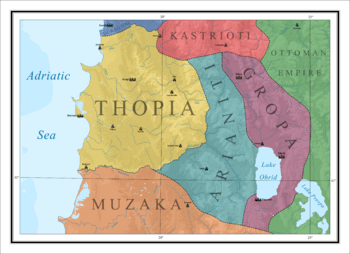Principality of Albania (medieval) facts for kids
Quick facts for kids
Principality of Albania
Principata e Arbërisë
|
|||||||||
|---|---|---|---|---|---|---|---|---|---|
| 1328–1415 | |||||||||

Domains of the Thopia, between 1385-1392
|
|||||||||
| Status | Principality | ||||||||
| Capital | Durrës | ||||||||
| Common languages | Albanian | ||||||||
| Religion | Roman Catholicism Eastern Orthodoxy | ||||||||
| Government | Principality | ||||||||
| Prince | |||||||||
|
• 1328-1338
|
Tanusio Thopia | ||||||||
|
• 1358–1388
|
Karl Thopia | ||||||||
| Historical era | Medieval | ||||||||
|
• Established
|
1328 | ||||||||
|
• Ottoman conquest
|
1415 | ||||||||
| ISO 3166 code | AL | ||||||||
|
|||||||||
The Principality of Albania (called Principata e Arbërisë in Albanian) was a medieval state in what is now Albania. It was ruled by the Thopia family, an important Albanian noble family. The principality started around 1328 with Tanusio Thopia, who was a count in the Mat region. Over time, control of the principality shifted between the Thopia family and the Balsha family. In 1392, the city of Durrës, a key part of the principality, was taken over by the Republic of Venice.
Contents
History of the Principality
One of the first important leaders of the Thopia family was Tanusio Thopia. He was mentioned in 1329 as one of Albania's counts. In 1338, King Robert of Naples officially recognized Tanusio as the Count of Matia. This showed the Thopia family's connection to the Angevins, a powerful European royal family.
By 1340, the Thopia family controlled a large area between the Mati and Shkumbin rivers. They, along with the Muzaka family, agreed to accept the Angevins as their rulers after fighting against the Serbs. However, only Andrea Muzaka actually fought the Serbs.
Serbian Conquest and Thopia's Return
Around 1343, the Serbian King Stefan Dušan conquered almost all of Albania. Only Durrës remained free, defended under the command of Tanusio.
After King Stefan Dušan died in 1355, the Thopia family got their lands back. They then ruled most of central Albania. In 1358, Karl Thopia rebelled against the Angevins. He managed to push them out of Epirus and most of Albania, except for Durrës. From 1358 to 1368, Karl Thopia ruled over large parts of central Albania. He called himself the "Prince of Albania."
Conquest of Durrës
Since 1362, Karl Thopia wanted to take control of Durrës. This city was held by Duchess Johanna of Anjou. His first attempt to capture the city lasted from April 1362 to May 1363. However, Thopia had to pull back his troops because many of them became sick.
It wasn't until 1367 that Karl Thopia finally conquered Durrës. He had quietly gained the support of the Venetians for his plan. Durrës was an important port city, and Karl Thopia made it his main residence. When Karl gained control of Durrës in 1368, it marked the end of the Angevins' Kingdom of Albania.
Conflict with the Balsha Family
Balša II tried for the fourth time to conquer Durrës. This city was a very important trading and military center. In 1382, Balša II started a war and successfully took Durrës from Karl Thopia.
In 1385, the defeated Karl Thopia asked the Ottoman Sultan Murad I for help. He wanted support against his rivals, the Balsha family from the Principality of Zeta. This decision meant inviting the powerful Ottoman Empire into Albania to help him defeat his enemies.
An Ottoman army, led by Hayreddin Pasha, quickly marched into Albania. They traveled along the Via Egnatia, an ancient Roman road. The Ottoman forces heavily defeated Balša II's army. Balša II himself was killed in a major battle near Lushnje in 1385. This battle, known as the Battle of Savra, ended the Balsha family's rule over Durrës. In 1392, Durrës fell under the control of the Republic of Venice.
Later Rulers and Ottoman Conquest
After Gjergj Thopia died, Niketa Thopia became the next ruler. He was also the last ruler of the principality. After the Ottoman Sultan Bayezid died in 1402, many Albanian lords, including Niketa, John Kastrioti, and Koja Zaharija, recognized Venice as their protector. The Venetians wanted a safe area between their lands and the advancing Ottoman army. Niketa continued to rule Kruje until 1415. In that year, Kruje fell under the control of the Ottoman Empire, which marked the end of the Principality of Albania.
Princes of Albania
| Prince | Reign | Notes |
|---|---|---|
|
Count of Matia |
1328-1338 |
|
|
|
1338-1343 |
|
 Karl Thopia Karl Thopiaprinceps Albanese |
1355–1383 |
|
 Balsha II Balsha IIduke of Durazzo |
1383–1385 |
|
 Karl Thopia Karl Thopia |
1385-1388 |
|
|
|
1388–1392 |
|
|
|
1392–1394 |
|
 Konstantin Balsha Konstantin Balsha |
1394–1402 |
|
|
|
1402–1403 |
|
|
|
1403–1415 |
|
See also
 In Spanish: Principado de Albania (medieval) para niños
In Spanish: Principado de Albania (medieval) para niños



